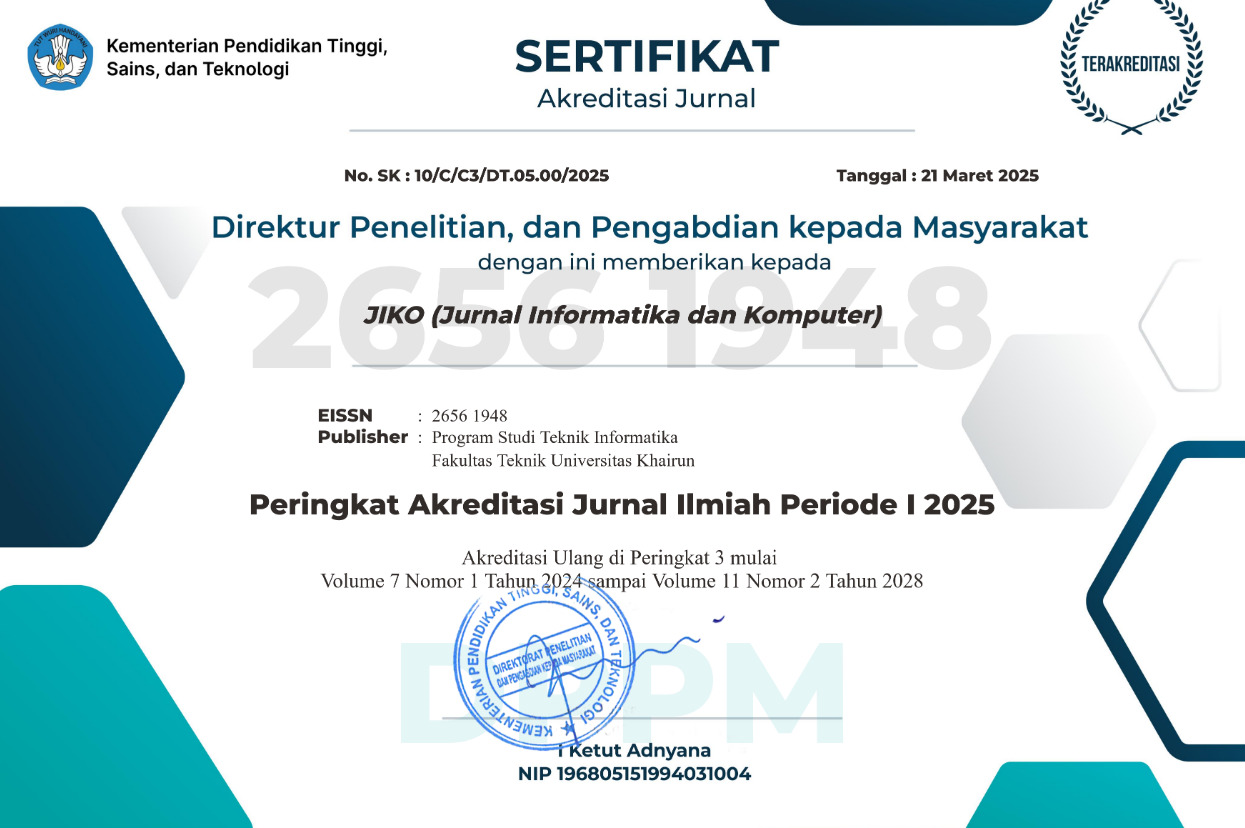APPLICATION OF THE K-MEANS AND DECISION TREE ALGORITHMS IN DETERMINING STUDENT ACHIEVEMENT
Abstract
Various factors influence student achievement, both internal and external; this makes it difficult for some teachers to detect every student in class. This research aims to determine student achievement in class among students at the SDS Kartika X-6 school. Data comes from SDS Kartika X-6, an elementary school owned by the Indonesian Army. By knowing the factors that influence the determinants of student learning achievement, steps can be taken to improve student learning achievement at SDS Kartika x-6. The methods used in this research are the K-Means algorithm and Decision Tree. This method will be chosen to determine student learning achievement. The process begins by determining clusters using the K-Means algorithm; then a classification process is carried out using a Decision Tree. The number of datasets in this research is 28, and the criteria are gender, mathematics grades, English, natural sciences, religion, class performance, and school achievement. The implementation results show that academic grades, class achievements, and school achievements play a role in determining student achievement for SDS Kartika X-6 students. Meanwhile, 3 clusters were formed: Fairly Good, Good, and Very Good. In the testing stage using the Decision Tree method, prediction accuracy was 71%, with an error of 29.
Full Text:
PDFReferences
M. B. Abdul Majid, Y. M. Cani, and U. Enri, “Penerapan Algoritma K-Means dan Decision Tree Dalam Analisis Prestasi Siswa Sekolah Menengah Kejuruan,†Jurnal Sistem Komputer dan Informatika (JSON), vol. 4, no. 2, p. 355, Dec. 2022, doi: 10.30865/json.v4i2.5299.
H. Yuwafi, F. Marisa, and I. Darma Wijaya, “IMPLEMENTASI DATA MINING UNTUK MENENTUKAN SANTRI BERPRESTASI DI PP.MANAARULHUDA DENGAN METODE CLUSTERING ALGORITMA K-MEANS,†2019. doi: DOI: http://dx.doi.org/10.53567/spirit.v11i1.115.
T. Widiyanti, S. Shofiah Hilabi, A. Hananto, Tukino, and E. Novalia, “Implementasi K-Means dan K-Nearest Neighbors pada Kategori Siswa Berprestasi,†Implementasi K-Means dan K-Nearest Neighbors pada Kategori Siswa Berprestasi, vol. 5, 2023, doi: https://doi.org/10.37034/jidt.v5i1.255.
S. Dewi, S. Defit, and Y. Yuhandri, “Akurasi Pemetaan Kelompok Belajar Siswa Menuju Prestasi Menggunakan Metode K-Means,†Jurnal Sistim Informasi dan Teknologi, pp. 28–33, Mar. 2021, doi: 10.37034/jsisfotek.v3i1.40.
J. Hutagalung, Y. Hendro Syahputra, Z. Pertiwi Tanjung, S. Triguna Dharma, and J. I. Pintu Air, “Pemetaan Siswa Kelas Unggulan Menggunakan Algoritma K-Means Clustering,†Hal AH Nasution, vol. 9, no. 1, 2022, [Online]. Available: http://jurnal.mdp.ac.id
M. Sholeh and K. Aeni, “PERBANDINGAN EVALUASI METODE DAVIES BOULDIN, ELBOW DAN SILHOUETTE PADA MODEL CLUSTERING DENGAN MENGGUNAKAN ALGORITMA K MEANS,†2023. doi: http://dx.doi.org/10.30998/string.v8i1.16388.
M. Sinan, J. Leng, K. Shah, and T. Abdeljawad, “Advances in numerical simulation with a clustering method based on K–means algorithm and Adams Bashforth scheme for fractional order laser chaotic system,†Alexandria Engineering Journal, vol. 75, pp. 165–179, Jul. 2023, doi: 10.1016/j.aej.2023.05.080.
G. Gustientiedina, M. H. Adiya, and Y. Desnelita, “Penerapan Algoritma K-Means Untuk Clustering Data Obat-Obatan,†Jurnal Nasional Teknologi dan Sistem Informasi, vol. 5, no. 1, pp. 17–24, Apr. 2019, doi: 10.25077/teknosi.v5i1.2019.17-24.
A. Sulistiyawati and E. Supriyanto, “Implementasi Algoritma K-means Clustring dalam Penetuan Siswa Kelas Unggulan,†vol. 15, no. 2.
Z. Guo, Y. Shi, F. Huang, X. Fan, and J. Huang, “Landslide susceptibility zonation method based on C5.0 decision tree and K-means cluster algorithms to improve the efficiency of risk management,†Geoscience Frontiers, vol. 12, no. 6, Nov. 2021, doi: 10.1016/j.gsf.2021.101249.
S. Kurniawan, A. M. Siregar, and H. Y. Novita, “Penerapan Algoritma K-Means dan Fuzzy C-Means Dalam Mengelompokan Prestasi Siswa Berdasarkan Nilai Akademik,†vol. IV, no. 1, 2023.
E. Fernando, P. Mudjiraharjo, and M. Aswin, “IMPLEMENTASI PENDEKATAN COLLABORATIVE FILTERING DAN K-MEANS CLUSTERING PADA SISTEM REKOMENDASI MATA KULIAH,†Jurnal Informatika dan Komputer) Akreditasi KEMENRISTEKDIKTI, vol. 5, no. 2, 2022, doi: 10.33387/jiko.
M. A. Ayub, “ANALISIS TOPIK EKONOMI DENGAN ALGORITMA K-MEANS PADA MEDIA ONLINE ERA PANDEMI COVID-19 DI SULAWESI TENGGARA,†Jurnal Informatika dan Komputer) Akreditasi KEMENRISTEKDIKTI, vol. 4, no. 2, 2021, doi: 10.33387/jiko.
R. Anggraini, E. Haerani, J. Jasril, and I. Afrianty, “Pengelompokkan Penyakit Pasien Menggunakan Algoritma K-Means,†JURIKOM (Jurnal Riset Komputer), vol. 9, no. 6, p. 1840, Dec. 2022, doi: 10.30865/jurikom.v9i6.5145.
F. Salsabila and S. Maulida Intani, “IMPLEMENTASI ALGORITMA K-MEANS DAN C4.5 DALAM MENENTUKAN TINGKAT PENYEBARAN COVID-19 DI INDONESIA,†Kata Kunci : Algoritma C4, vol. 7, no. 1, 2021.
A. H. Nasrullah, “IMPLEMENTASI ALGORITMA DECISION TREE UNTUK KLASIFIKASI PRODUK LARIS,†vol. 7, no. 2, 2021, doi: https://doi.org/10.35329/jiik.v7i2.203.
E. Laber, L. Murtinho, and F. Oliveira, “Shallow decision trees for explainable k-means clustering,†2022. doi: https://doi.org/10.1016/j.patcog.2022.109239.
DOI: https://doi.org/10.33387/jiko.v7i1.7580
Refbacks
- There are currently no refbacks.











